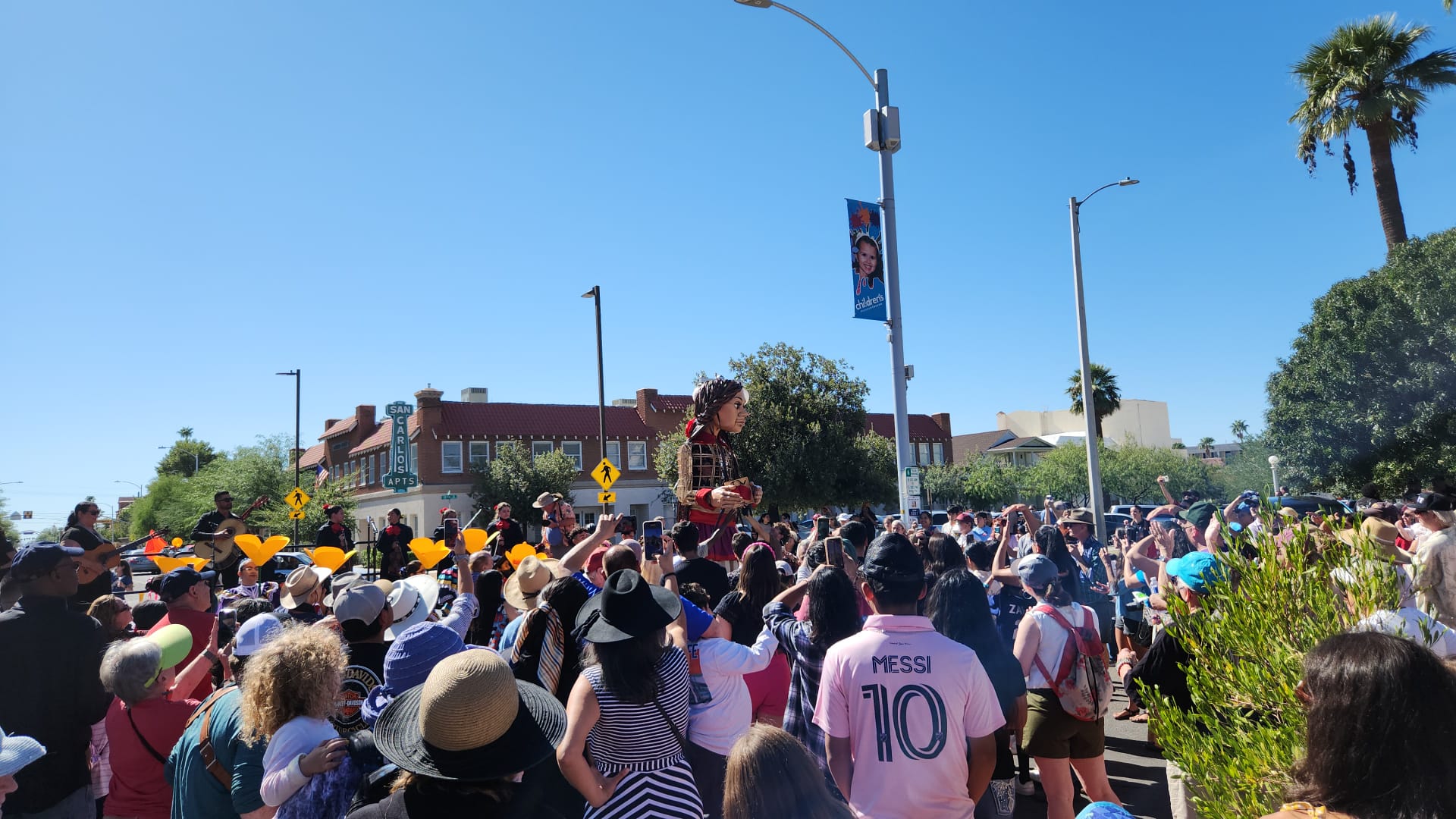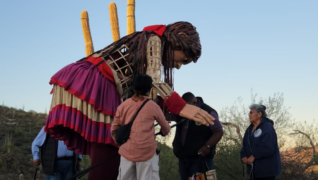Our Experience With Amal’s Walk
by Katrinka Heyman
Last month, Jen Rosenstein invited our Waldorf community to share in welcoming “Little Amal” (Arabic translation: “Hope”), a 12-foot puppet in the likeness of a 10-year old Syrian girl traveling the world as a refugee seeking a new life, hoping to reconnect with family and friends from her homeland. Her story represents that of tens of thousands of displaced children, often separated from their own families. Over the last 2 years, she has walked through 15 countries, from Syria and Turkey through Europe and the US, and this month she began her journey through México.
On October 28th, at the third of four events of “The Walk” in Tucson, Little Amal was welcomed to the streets around Armory Park and the Children’s Museum. Those who came were offered white crocheted hearts at the Birdhouse Yarns’ booth, some of which were made with love by Waldorf family hands over the fall break period. Earlier that day, she learned the word “Saguaro” from the quiet company of a few hundred welcoming her to the Sonoran Desert, and witnessed a sunrise blessing honoring ancestral land by members of the O’Odham Nation on Cemamagi Du’ag (Tumamoc Hill). Then from a South-Side community breakfast, Little Amal was escorted in style and with love by Tucson Lowriders to Armory Park where she danced at a street party to “Lowrider,” blasted from a Tucson Police car’s speakers. Folklórico dancers and mariachi music then danced with her to the Museum, with handwritten signs in many languages from the crowd saying “WELCOME,” waving to her while live Middle Eastern music played and the community danced and beckoned for her to join the familiar sounds of home at the end.
When we heard of Amal’s visit to Tucson, I knew I wanted to be a part of it, for so many reasons. To witness the coming together of community in reverence; to be in the energetic space of a project that had traveled almost 12,000 miles for the purpose of connecting hearts, activating interest, concern, and support around asylum seekers and refugees; to hear what conversations would emerge around her; essentially, to awaken more.
Our 2 boys, Nasuh (8) and Kaya (10), knew that I was going early in the morning to pick up Tía Camille on the way to the sunrise blessing at Tumamoc. I told them they could come with me if they woke up with a gentle try from me at 4:40 a.m., and could get dressed in 3 layers and a hat to be in the car by 5 a.m.. They did it. I asked why they wanted to come. They had various reasons: they love sunrise, they wanted to drive with Tía Camille, they wanted to be with me. But really, I saw their interest when I showed the UN video I found about her journey and we watched it together, over and over. They couldn’t get enough. She drew them in. They didn’t want to miss out on the something they didn’t understand but knew would be really special.
The feeling on Tumamoc at 6 a.m. was quiet & reverent, with excited anticipation from the children. Some people had traveled long distances to come be with Amal. When she started out on the walking path, she turned back a second and leaned down to cup Nasuh’s face in her hands. It was a very human moment, full of emotion. It was so touching that she, in her own search for connection and belonging, stopped to acknowledge another small child on her path. You could see a flash of the puppeteer inside her chest, moving her body through space, and the support on either side of her, animating her arms and hands. Both her physical and facial expressions, as well as the materials she’s made of, truly gave a magical and hopeful feeling to her presence. She closed her eyes to take in the prayers and songs offered, and bent down to hug each person when finished.
Nasuh was a little confused about why people were getting so emotional when he knew she wasn’t real. Being such an imaginative child, I thought he would get lost in her expressions, but instead he was intently focused on how she was put together and moved about mechanically, which is also why Kaya wanted to see her in person. Once we arrived at the gathering place, they both were completely focused throughout the storytelling and blessing and songs offered. The message was clearly one of welcoming; that no one will ever be turned away from this land and people, that all are welcome and we care for one another and the Earth, as the Earth cares for us. And this, coming from the representative of indigenous caretakers of this land who have been the recipients of violence, oppression, separation, and expulsion for generations, now offering a generosity of spirit for all of us to take humble, instructive guidance from. The central puppeteer animating her body was moved to tears throughout the O’Odham blessing, and I thought about all the thousands of faces he and other crews who work with Amal (they switch between events and catch a break) have seen. Every human reality and emotion, and inevitably, meeting people who are themselves separated from loved ones and in a foreign land, seeking asylum.
We followed her eventually to the end of the South-Side party which was festive and down to earth, with families, neighbors and business owners all out waving to her as she passed by. The reception at Armory Park was exactly a street party, full of joy as she mimicked the dance and music being played for her. From a distance, we all started to hear music that was from the Middle East and she looked like a child hearing something from home for the first time in years. She had adapted to her environment, observed, learned, and played along. But now she almost hid behind a palm tree, wondering if this could in fact be something from home. It was incredibly moving and played out the drama in a way I didn’t anticipate could feel so real, so tangible, with a giant puppet. She was being reunited with a piece of her heart, people who ate and spoke and danced and played music like she knew, and she eventually walked towards them and joined in what was a very intentional full-circle message: one can leave home and find home, and we each can be a part of making the belonging happen.
“The purpose of The Walk is to highlight the potential of the refugee, not just their dire circumstances. Little Amal is 3.5 metres tall because we want the world to grow big enough to greet her. We want her to inspire us to think big and to act bigger.” – Amir Nizar Zuabi, Artistic Director of The Walk


